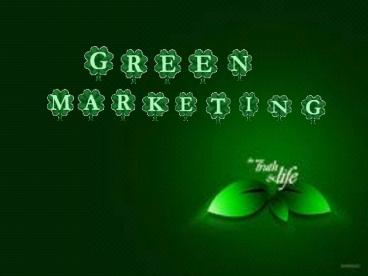green marketing - PowerPoint PPT Presentation
Title:
green marketing
Description:
about green market... – PowerPoint PPT presentation
Number of Views:12268
Title: green marketing
1
(No Transcript)
2
In recent years the term green or eco marketing
have come to prominence and reflect a growing
concern at all levels of the impact of the
increased consumption on physical
environment. The implications of the
destruction of the forests , the appearance of
holes in the ozone layer etc were widely
published and created a wave concern about the
destruction of our natural environment. Therefor
e many consumers are in favour of eco-friendly
products .This has created some impact on
marketing .
3
- Green marketing refers to the process of selling
products or services based on their environmental
benefits. Such a product or service may be
environmentally friendly in itself or produced or
packaged in an environmentally friendly way.
4
- Many manufacturers have recognized environmental
concerns as a source of competitive advantage
and have developed products with a green image
5
- Macdonalds have stopped packaging their
hamburgers etc in polystyrene containers and
now use cardboards which comes from a renewable
resource and is biodegradable or recyclable .
6
REQUIREMENTS
The production process is compatible with
ecosystem
It is compatible with goals of the company
It satisfies the consumers
7
ECO LABELLING
Eco label is an environmental claim that
appears on the packaging of a product .It is
awarded to a manufacturer by an appropriate
authority. ISO 14020 is a guide to the award
of Eco-labels. The government of India
launched an Eco-mark Scheme in 1991 to increase
consumer awareness in respect of environment
friendly products.The aim of the scheme is to
encourage the customers to purchase those
products which have less harmful environmental
impact.
8
Eco labeling leads to
- Improvement of image and sales of products
- Manufacturers being more accountable to
environmental impacts. - Consumers awareness that their choice of product
do affect the environment as some products are
less damaging to environmental than others
9
OPERATON OF ECO-MARK SCHEME OF GOVERNMENT OF INDIA
- 3 stages led to award of eco-mark in India
The Steering Committee of the MEF determines
the product categories for coverage under the
scheme and to formulate strategies for
implementation and future developments of the
scheme.
The second stage is the identification of
specific products to be selected and the
individual criteria to be adopted by the
Technical Committee of CPCB.
In the third stage the Bureau of Indian
Standards (BIS) is to certify the product and
formulae contract with the manufacturer allowing
the use of eco-mark.
10
- Products to meet the relevant standards of BIS.
- Manufacturers to produce documentary evidence in
regard to compliance of EPA.Water and Air Acts
and other rules and regulations such as
Prevention of Food Adulteration Act and rules
made there under. - The product to display the list of critical
ingredients in descending order of quantity
present. - The packaging to display the criteria based on
which the product has been labelled environment
friendly. - The material used for packaging to be
recyclable./ reusable /biodegradable. - The products to be accompanied by detailed
instructions for proper use.
CRITERIA FOR ECO-MARK
11
- Soaps and detergents
- Paper
- Food items
- Lubricating oils
- Packaging materials
- Paints and powder coatings
- Batteries
- Electrical / electronic goods
- Food addition
- Wood substitutes
- Cosmetics
- Aerosol propellants
- Plastic product
- Textiles
- Fire extinguisher
- Leather
STATUS FOR ECO-MARK DEVELOPMENT
12
(No Transcript)































